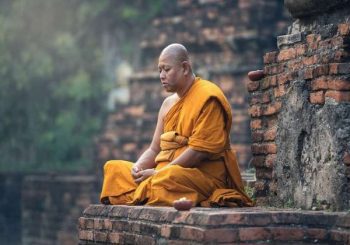 By Nikki Harper
By Nikki Harper
Contributing Writer for Wake Up World
Most of us are familiar with – and fascinated by – the concept of near death experiences. We know the imagery of the tunnel of light and the we’ve read the accounts of people who have faced a choice of staying or returning to their lives. Near death experiences are more common than you might think, reported by approximately 17% of adults who have been in a situation where they were close to death [1]. But is it possible to have a near death experience without being close to death? And if so, what could we learn from that?
[pro_ad_display_adzone id=”110028″]
According to research undertaken by the University of Derby in 2018, yes, near death experiences can be deliberately and consciously induced by advanced Buddhist meditation practitioners [2]. The longitudinal study, carried out over three years and published in the journal Mindfulness, followed the experiences of twelve advanced practitioners as they underwent a variety of rich and varied near death experiences.
Buddhism and Death Awareness
Death awareness has always been a key factor in Tibetan Buddhism. Because Buddhists believe that attachment is at the root of human suffering, meditating on death is thought to help to remove attachment and therefore to ease spiritual understanding and growth.
Ancient texts like the Tibetan Book of the Dead give explicit instructions for such death meditation, and practices such as maranasati meditation [3] can help us to understand the impermanence of life, and to prepare for the inevitability of death.
As Buddha himself is believed to have said, “Of all the footprints, that of the elephant is supreme. Similarly, of all mindfulness meditation, that on death is supreme.” [4] Tibetan Buddhism talks of delogs, people – usually but not always women – who could spend days or even weeks in a near death state, and whose purpose was to report their experiences to others. [5]
There is therefore considerable evidence that some Buddhist practitioners do engage in meditation which is intended to bring familiarity with death and with the dying experience. Prior to the University of Derby study, however, such experiences had never been fully investigated.
Buddhist Meditation Near Death Experiences
As far back as 1990, it was established that one does not have to be at the point of death in order to have a near death experience [6]. The University of Derby study confirmed that the twelve chosen practitioners did indeed have meditative experiences which were very much in line with accepted near death commonalities.
The majority of near death experiences consist of the same key stages or components [7]:
- An out of the body experience
- A tunnel
- Communication with a light or a being of light
- View of a heavenly or celestial landscape
- Meeting with deceased relatives
- A life review
- A loss of time and/or space
- A conscious return to the body
Researchers found that all of these components were present in all of the practitioners’ reported meditative NDEs. In particular, all practitioners reported meeting with deceased persons, all reported seeing a wide range of landscapes and environments – including unpleasant ones – and all reported a sensation that time and space did not exist.
Participants were asked to score themselves, following each NDE, on three different scales: the Near Death Experience Scale [8], the Mysticism Scale [9], and the Non-Attachment Scale [10]. The results showed that participants across the three years had experienced a five-fold increase in mystical experience and a four-fold increase in non-attachment, compared to the control group of meditators. This suggests that meditative NDEs can be improved and strengthened with practice.
What Can We Learn from Meditative NDEs?
As the study authors point out, their research opens the gateway for future neurological research into NDEs. This has previously been very difficult, due to medical and ethical considerations with patients who are close to death. By being able to study the real time neurological changes in meditators who are undergoing a near death experience, we could potentially learn an enormous amount about the process of death and dying.
Importantly, we can also learn a lot about our psychological approach to death, which could lead to improved end of life care. It would appear that spiritually meaningful insights can be gained from the contemplation of death, yet it continues to be a taboo subject for much of society.
It takes many years to reach an advanced stage of meditation practice where a meditative NDE may become possible and clearly most of us will never reach that stage. However, all of us can undertake maranasati meditation, or simply spend some time now and then contemplating death and what it means for us as living beings. We know that people who have undergone near death experiences almost universally report it as being a transformative experience in their life. You may think that contemplating death is morbid but done properly it can bring a sense of peace, acceptance and a greater appreciation for life.
Article sources:
- [1] https://www.ncbi.nlm.nih.gov/pmc/articles/PMC6172100/
- [2] https://link.springer.com/article/10.1007/s12671-018-0922-3
- [3] https://www.buddhistinquiry.org/article/shining-the-light-of-death-on-life-maranasati-meditation-part-i/
- [4] https://tricycle.org/trikedaily/family-dharma-the-elephants-footprint/
- [5] https://link.springer.com/article/10.1023/A:1026461521146
- [6] https://www.thelancet.com/journals/unidentified_journal/article/PII0140-6736(90)92780-L/fulltext
- [7] https://www.sciencedirect.com/science/article/pii/S0140673601071008
- [8] https://pdfs.semanticscholar.org/f065/5889d23d3c72c41231a9c43e1b0765ef8926.pdf
- [9] https://www.jstor.org/stable/1384454
- [10] https://www.tandfonline.com/doi/abs/10.1080/00223890903425960
Recommended articles by Nikki Harper:
- Harnessing the Power of Synchronicity
- Beyond 11:11 – The Significance of Repeating Number Patterns
- A Time to be Born and a Time to Die: Can Astrology Predict Death?
- Premature and Caesarean Birth: An Astrological Misinheritance?
- The Benefits of a Daily Divination Practice – and How to Start One
- 7 Ways to Find Awe in Your Everyday Life
- Need Answers? Looking for Insight? 7 Ways Astrology Can Help
- Alone But Not Lonely: 6 Amazing Benefits of Solitude
- Dancing in the Rain: 6 Reasons We Should All Be Pluviophiles
- Finding Time for a Daily Spiritual Practice – How and Why to Devote Your Time
- 7 Simple Steps to Start Communicating With Nature
- Getting Started with Remote Viewing: Step by Step to Strengthen Your Psi Abilities
About the author:
 Nikki Harper is a spiritualist writer, astrologer, and editor for Wake Up World. She writes about divination, astrology, mediumship and spirituality at Questionology: Astrology and Divination For the Modern World where you can also find out more about her work as a freelance astrologer and her mind-body-spirit writing and editing services. Nikki also runs a spiritualist centre in North Lincs, UK, hosting weekly mediumship demonstrations and a wide range of spiritual development courses and workshops.
Nikki Harper is a spiritualist writer, astrologer, and editor for Wake Up World. She writes about divination, astrology, mediumship and spirituality at Questionology: Astrology and Divination For the Modern World where you can also find out more about her work as a freelance astrologer and her mind-body-spirit writing and editing services. Nikki also runs a spiritualist centre in North Lincs, UK, hosting weekly mediumship demonstrations and a wide range of spiritual development courses and workshops.
Say hi at Questionology.co.uk or on Facebook.
[pro_ad_display_adzone id=”110027]






